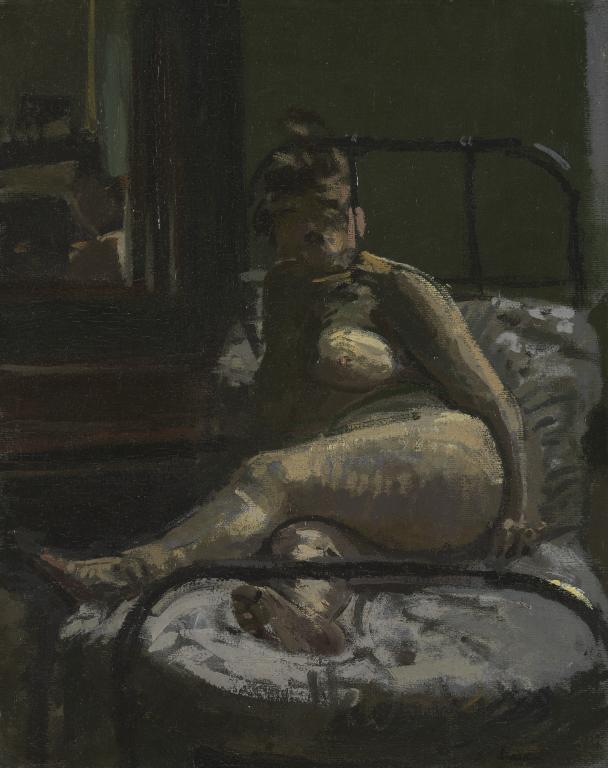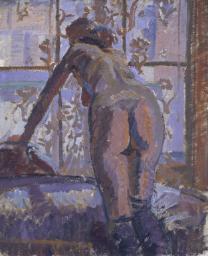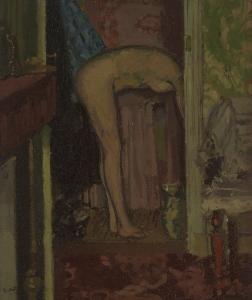Walter Richard Sickert La Hollandaise c.1906
Walter Richard Sickert,
La Hollandaise
c.1906
The title of this picture translates as ‘The Dutch Girl’ and may be derived from a minor character who is a prostitute in work by the French novelist Balzac. It is ambiguously applied to the nude figure shown here on a mattress among crumpled bedclothes, leaning on her right arm with legs clumsily crossed. Cast in deep shadow with no visible facial features, her left breast and thigh nevertheless glow in bright light, the pale skin emphasised with blue and olive tones as well as grey underpainting. Sickert’s signature iron bedstead features prominently; functional and hard-wearing but also unrefined, it echoes the urban working class interior scenes he preferred.
Walter Richard Sickert 1860–1942
La Hollandaise
c.1906
Oil paint on canvas
511 x 406 mm
Purchased 1983
T03548
c.1906
Oil paint on canvas
511 x 406 mm
Purchased 1983
T03548
Ownership history
Goupil Gallery, London; sold Christie’s, London, 28 January 1927 (148); Mark Oliver, sold Sotheby’s, London, 29 November 1944 (129); sold Tooth, London; Hart and Massey, London; sold Roland, Browse and Delbanco, London, 1959; Peter Shand-Kydd 1960; Mrs Janet Shand-Kydd, from whom bought through Browse & Darby, London, by Tate Gallery 1983.
Exhibition history
1907
Sickert, Bernheim-Jeune, Paris, January 1907 (33).
1909
Vente de 84 Oeuvres de Walter Sickert, Bernheim-Jeune, Hôtel Drouot, Paris, June 1909 (54).
1925
Summer Exhibition, Goupil Gallery, London 1925 (79).
1953
Coronation Exhibition, Redfern Gallery, London 1953 (49, reproduced).
1957
Sickert Paintings and Drawings, Roland, Browse and Delbanco, London, May–June 1957 (24, ‘La Belle Hollandaise’).
1960
Sickert 1860–1942, Roland, Browse and Delbanco, London, March–April 1960 (30, reproduced).
1960
Sickert: Paintings and Drawings, (Arts Council tour), Tate Gallery, London, May–June 1960, Southampton Art Gallery, July 1960, Bradford City Art Gallery, July–August 1960 (100, reproduced).
1973
Sickert, Fine Art Society, London, May–June 1973 (49).
1981
Sickert, Browse & Darby, London, November–December 1981 (14, reproduced).
1989–90
W.R. Sickert: Drawings and Paintings 1890–1942, Tate Gallery, Liverpool, March 1989–February 1990, Tate Gallery, London, July–September 1990 (4, reproduced).
1992
The Painted Nude: From Etty to Auerbach, Tate Gallery, London, August–October 1992 (7).
1992–3
Sickert: Paintings, Royal Academy, London, November 1992–February 1993, Van Gogh Museum, Amsterdam, February–May 1993 (49, reproduced).
1998
James McNeill Whistler, Walter Richard Sickert, Fundación ‘La Caixa’, Madrid, March–May 1998, Museo de Bellas Artes, Bilbao, May–July 1998 (80, reproduced).
1998–9
An Ordinary Life: Camden Town Painters, Aberdeen Art Gallery, November 1998–January 1999 (32).
2001–3
Exposed: The Victorian Nude, Tate Britain, London, November 2001–January 2002, Haus der Kunst, Munich, March–June 2002, Brooklyn Museum of Art, New York, September 2002–January 2003, Kobe City Museum, February–May 2003, Geidai Museum, The University Art Museum, Tokyo, June–August 2003 (164, reproduced).
2004
Walter Richard Sickert: The Human Canvas, Abbot Hall Art Gallery, Kendal, July–October 2004 (16, reproduced).
2005–6
Degas, Sickert, Toulouse-Lautrec: London and Paris 1870–1910, Tate Britain, London, October 2005–January 2006, Phillips Collection, Washington D.C., February–May 2006 (100, reproduced).
2007
Walter Sickert: The Camden Town Nudes, Courtauld Institute of Art, London, February–September 2007 (8, reproduced).
2008
Modern Painters: The Camden Town Group, Tate Britain, London, February–May 2008 (57, reproduced).
References
1960
Lillian Browse, Sickert, London 1960, pp.72, 73, pl.46.
1960
Wendy Dimson, ‘Four Sickert Exhibitions’, Burlington Magazine, vol.102, no.691, October 1960, pp.441, 442, reproduced fig.29.
1961
John Rothenstein, Sickert, London 1961, [p.16], reproduced pl.7.
1967
Ronald Pickvance, Sickert, London 1967, reproduced pl.VIII.
1973
Wendy Baron, Sickert, London 1973, pp.86–7, 101, 110, 338, no.211, reproduced pl.144.
1979
Wendy Baron, The Camden Town Group, London 1979, pp.10, 110, 118, 146, reproduced pl.7.
1980
Wendy Baron, ‘The Perversity of Walter Sickert’, Arts Magazine, vol.55, no.1, September 1980, reproduced fig.3.
1981
Andrew Causey and Richard Thomson (eds.), Harold Gilman 1876–1919, exhibition catalogue, Arts Council, London 1981, p.29.
1984
‘Twentieth Century European Paintings and Sculpture Recently Acquired by Museums’, Burlington Magazine, acquisitions supplement ,vol.126, no.971, February 1984, p.127, reproduced fig.71.
1988
Richard Shone, Walter Sickert, Oxford 1988, pp.36, 40, reproduced pl.25.
1988
Belinda Thomson, Vuillard, Oxford 1988, p.76, reproduced pl.54.
1994
Eredità dell’impressionismo 1900–1945: La Realtà interiore, exhibition catalogue, Palazzo delle Esposizioni, Rome 1994, reproduced fig.ii, p.168.
1996
Andrew Graham-Dixon, A History of British Art, London 1996, p.220.
1996
Anna Gruetzner Robins, Walter Sickert: Drawings, Aldershot and Vermont 1996, pp.42, 95 n.42.
1997
James Malpas, Realism, London 1997, reproduced fig.7.
2000
Lisa Tickner, Modern Life and Modern Subjects: British Art in the Early Twentieth Century, New Haven and London 2000, p.20, reproduced pl.16.
2000
Wendy Baron, Perfect Moderns: A History of the Camden Town Group, Aldershot and Vermont 2000, p.204.
2001
David Peters Corbett, Walter Sickert, London 2001, pp.30, 38–9, reproduced fig.22.
2001
Richard Humphreys, Tate Britain Companion to British Art, London 2001, p.168, reproduced p.169.
2001
James Hyman, The Battle for Realism: Figurative Art in Britain During the Cold War 1945–1960, New Haven and London 2001, reproduced pl.53.
2002
Rebecca Daniels, ‘Walter Sickert and Urban Realism: Ordinary Life and Tragedy in Camden Town’, British Art Journal, Spring 2002, p.60, reproduced pl.2.
2004
Roy Hattersley, The Edwardians, London 2004, pp.353–4.
2006
Valerie Webb, The Camden Town Group: Representations of Class and Gender in Paintings of London Interiors, Guildford 2006, p.50.
2006
Wendy Baron, Sickert: Paintings and Drawings, New Haven and London 2006, no.252, pp.57–58, 74, 312, reproduced.
2007
Stephen Deuchar, Martin Myrone et al., Tate Britain: 100 works from the Tate Collection, London 2007, p.70, reproduced.
Technique and condition
Walter Sickert purchased a pre-primed canvas from the London artists’ colourmen Percy Young, whose faded stamp marks the back of the canvas and is also impressed into one of the stretcher bars. The cloth is coarse-textured hemp; on its back is a circular ink stamp, which may be a canvas batch number or customs stamp suggesting that the cloth was imported.
The canvas has been sized and fully primed with a layer of gypsum and zinc white followed by a thin opaque layer of lead white and chalk.1 The primer extends to the turnover edges and retains much of the rough canvas-weave texture. Sickert loosely brushed on a thin mid-grey layer over the commercial priming to function as an optical ground. There is no visible evidence of any preliminary drawing or squaring-up on the primed canvas, but there are evenly spaced pinholes on both vertical edges that are positioned parallel on either side and some more randomly positioned along the horizontal edges, which may relate to a method of measuring or marking out the canvas with threads stretched across the face.
The artist started painting by blocking in the main compositional forms in relatively opaque patches of brown, green and grey colours in muted tones applied directly onto the optical ground. This would have been allowed to dry before further blocks of solid colour were applied using the same muted tones to define and redefine formal and spatial boundaries. The grey ground, left exposed or overlaid in parts, functioned as a neutral mid-tone and maintained a tonal balance: it can be seen in the bridge of her nose and the sockets of her eyes and in the bedclothes, for example. The composition was built up in this way in several stages over the dried ground, abstracting form and playing with positive and negative space; for example, the shoulder and right breast of the figure have been overpainted in the later stages of painting in the same green as the background to depict the right side of the figure’s torso in shadow. The main composition does not appear to have been modified during painting, except for a slight reduction in the length of the figure’s toe.
The final stages of painting were worked quickly and vigorously in a brighter key, the artist applying fluid impasto, rough scumbles and brief linear strokes to introduce touches of detail and colour with some wet-in-wet working. The work was probably carried out in Sickert’s studio using a posed model and worked over several sittings. While it retains the freshness of painting from life, reinforced in the final stages of painting, the subject is contrived and is not as momentary as it appears. The painting was probably originally varnished but has been cleaned and revarnished during its history due to discolouration of the original varnish.
Stephen Hackney
June 2005
Notes
How to cite
Stephen Hackney, 'Technique and Condition', June 2005, in Nicola Moorby, ‘La Hollandaise c.1906 by Walter Richard Sickert’, catalogue entry, March 2007, in Helena Bonett, Ysanne Holt, Jennifer Mundy (eds.), The Camden Town Group in Context, Tate Research Publication, May 2012, https://wwwEntry
Background
If there is one physical object which characterises Walter Sickert’s art, it is the iron bedstead which formed the centrepiece of numerous figure studies painted in London during the period 1905–9. This lowly piece of domestic furniture became the artist’s trademark, synonymous with both the subject matter and ethos of his paintings. His friend and model Cicely Hey, for example, described herself as the ‘last occupant’ of the iron bedstead,1 while the artist Diana White ironically asked Sickert if her niece, Regina Middleton, was required to buy one in order to become his pupil.2
The bed served a dual purpose as prop. Sickert organised his studio models in a series of poses based around the bed which allowed him to explore different figurative arrangements within an intimate environment. The physical appearance of the iron bedstead, however, was also important. It became symbolic of the social subjects Sickert sought to portray in his work, being functional and hard-wearing but also cheap and unrefined. It served as a metaphor for the urban working classes and the dingy London interiors – so beloved by the artist – which they inhabited. The iron bedstead appears principally in a number of pictures of the female nude from 1905–6, which later culminated in a series of works from 1908–9 known as the Camden Town Murder paintings.
Description
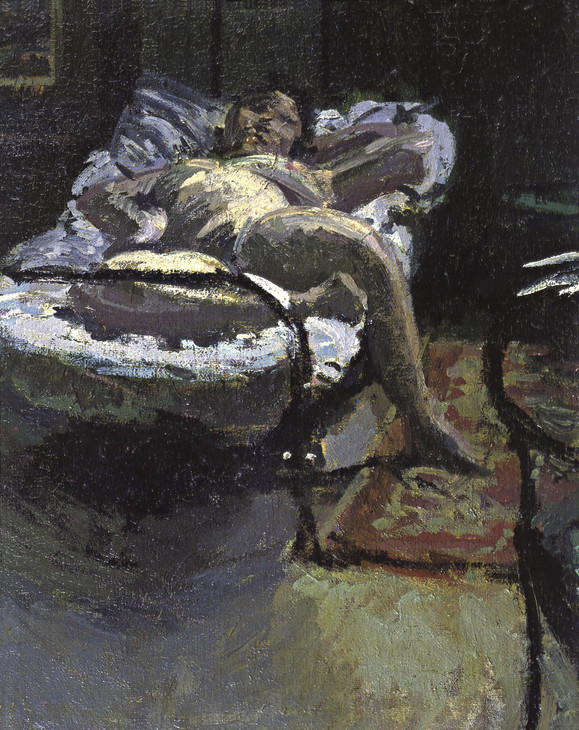
Walter Richard Sickert 1860–1942
Nuit d'été c.1906
Oil on canvas
450 x 380 mm
Private collection, Ivor Braka Ltd
© Estate of Walter R. Sickert / DACS
Photo © Ivor Braka Ltd, London
Fig.1
Walter Richard Sickert
Nuit d'été c.1906
Private collection, Ivor Braka Ltd
© Estate of Walter R. Sickert / DACS
Photo © Ivor Braka Ltd, London
No other painting seems to so readily bring to mind Sickert’s famous utterance that ‘the plastic arts are gross arts, dealing joyously with gross material facts’.7 There is no idealisation of the naked body. Rather, Sickert seems to revel in the model’s heavy form and unflattering arrangement of limbs. He makes no attempt to accommodate his technique in deference to the portrayal of flesh, but instead uses broad but controlled brushstrokes and livid patches of colour to emphasise the materiality of the painted surface. Consequently, some commentators have found his treatment of the figure disturbing, akin to a violation of the body. The diagonal streaks of paint on the thigh, for example, have been associated with a violent, misogynistic approach, while the use of various colours such as blue, olive green and grey can be suggestive of the discolouration of bruising.8 The art historian Rebecca Daniels has suggested that the triangular blank spaces of her face are indicative of the degenerative cavities created by tertiary syphilis.9
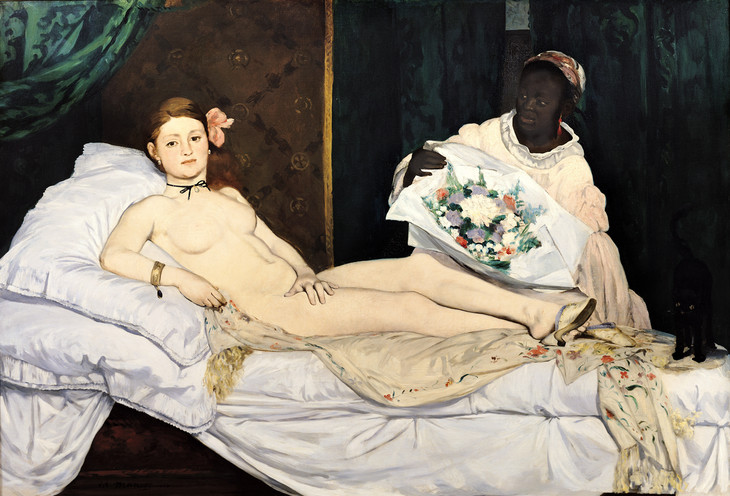
Edouard Manet 1832–1883
Olympia 1863
Oil paint on canvas
1300 x 1900 mm
Musee d’Orsay, Paris
Photo © Musee d’Orsay, Paris, France / Giraudon / The Bridgeman Art Library
Fig.2
Edouard Manet
Olympia 1863
Musee d’Orsay, Paris
Photo © Musee d’Orsay, Paris, France / Giraudon / The Bridgeman Art Library
‘The naked and the Nude’
As with much of Sickert’s work it is not entirely clear what effect the artist intended to create. When viewed in the context of Sickert’s views on the nude, the treatment of the body in La Hollandaise can be read, not as disturbing, but as painterly. In Sickert’s opinion paintings should always show ‘someone, somewhere’.11 He firmly outlined his beliefs in an article in the New Age, July 1910, entitled ‘The naked and the Nude’, in which he condemned art school practice which taught students to draw idealised, ‘lifeless’ nudes without reference to the real world. Instead, he articulated, the focus should be placed on drawing the clothed figure, or at least figures set within a real environment in which context their nakedness made some sense. He concluded:
Perhaps the chief source of pleasure in the aspect of a nude is that it is in the nature of a gleam – a gleam of light and warmth and life. And that it should appear thus, it should be set in surroundings of drapery or other contrasting surfaces.12
In La Hollandaise the mottled appearance of the skin is a study of the effects of colour and light on the body, and certain areas such as the left breast are elegantly and delicately painted. It is certain, however, that Sickert was aware of the complex multiplicity of the image, and despite intending the painting to be an aesthetic treatment of the body, he was by no means innocent of its provocative and disturbing possibilities.
Sickert went on to exploit these possibilities even further in his most notorious set of works, the Camden Town Murder paintings, 1908–9. These pictures, which referred to the recent local murder of a prostitute, caused a sensation when exhibited at the first Camden Town Group exhibition in June 1911. Once again, the ubiquitous iron bedstead featured as the central focal point around which Sickert organised a figural tableau. Unlike his earlier series, however, the artist now paired an unclothed female with a fully dressed male which greatly altered the context of the nude in an interior. In paintings such as The Camden Town Murder or What Shall We Do About the Rent? c.1908 (fig.3)13 and L’Affaire de Camden Town 1909 (fig.4),14 the inclusion of a clothed male protagonist introduces an implied narrative of violence and sex. Although not as extreme or overt, these sordid undercurrents are present in La Hollandaise.
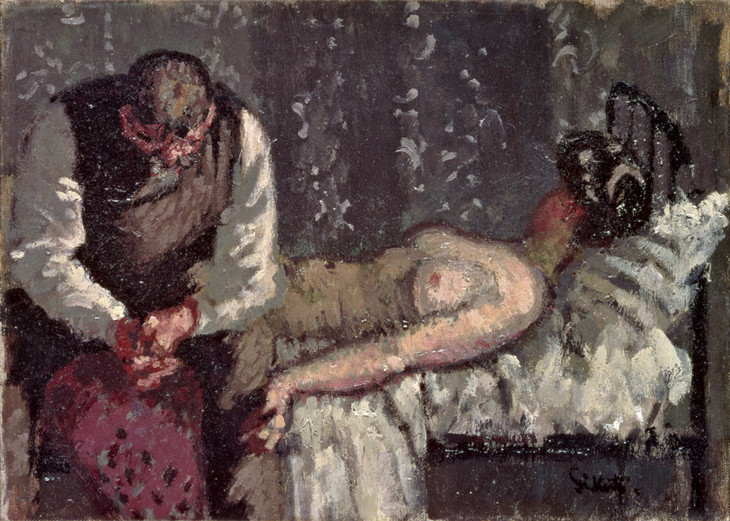
Walter Richard Sickert 1860–1942
The Camden Town Murder or What Shall We Do about the Rent? c.1908
Oil paint on canvas
256 x 356 mm
Yale Center for British Art, Paul Mellon Fund B1979.37.1
© Estate of Walter R. Sickert / DACS
Fig.3
Walter Richard Sickert
The Camden Town Murder or What Shall We Do about the Rent? c.1908
Yale Center for British Art, Paul Mellon Fund B1979.37.1
© Estate of Walter R. Sickert / DACS
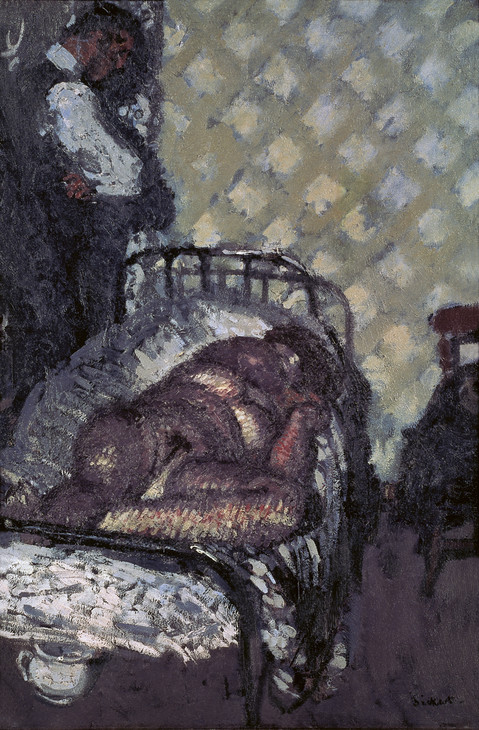
Walter Richard Sickert 1860–1942
L'Affaire de Camden Town 1909
Oil paint on canvas
610 x 406 mm
Private collection
© Estate of Walter R. Sickert / DACS
Photo © Photographic Survey, Courtauld Institute of Art
Fig.4
Walter Richard Sickert
L'Affaire de Camden Town 1909
Private collection
© Estate of Walter R. Sickert / DACS
Photo © Photographic Survey, Courtauld Institute of Art
‘La Hollandaise’
The art historian Richard Shone has suggested that the title may have been inspired by one of the minor incidental female characters in the novels of Honoré de Balzac. Sarah Gobseck, a prostitute who appears in several of the stories of Balzac’s La Comédie humaine, is familiarly known as ‘la belle Hollandaise’. This ‘magnificent creature’ is purported to be the grand-niece of a Dutch money-lender who leads an immoral and wanton life and is eventually murdered by one of her clients. The title of the painting, therefore, is possibly intended to project connotations of prostitution, or, less specifically, to be representative of a generic grim realism. In Balzac’s Rise and Fall of Cesar Birotteau (published 1838), the character is described as ‘one of those mad-cap women who care nothing as to where the money comes from, or how it is obtained ... she never thought of the morrow, for her the future was after dinner, and the end of the month eternity, even if she had bills to pay’,15 a statement which may have appealed to Sickert as reminiscent of his own imprudent character.
The title of La Hollandaise translates as ‘The Dutch Girl’ and may reflect a sense of seriality when linked to other works of this period. It is one of a number of paintings by Sickert with similarly continental titles, for example La Jolie Veneitienne 1903–4 (private collection),16 La Belle Sicilienne c.1905 (David Fullen),17 La Belle Rousse c.1905 (private collection),18 Les Petites Belges 1906 (Museum of Fine Arts, Boston),19 and The Belgian Cocotte 1906 (Arts Council Collection, London).20 Furthermore, as Wendy Baron has noted, the foreshortened figure and crossed placement of limbs recalls Sickert’s earlier group of Venetian nudes, for example, Conversations 1903–4 (private collection).21 Sickert himself was a cosmopolitan character, equally at home in London, Dieppe or Venice. Despite reducing the means of identifying one model from another to a label indicating their nationality, he was not actually interested in analysing cultural difference. Rather his titles reflect the sameness of his approach. His interest lay in finding models from within a certain class of woman and painting them in a variety of poses, both nude and clothed, against an interior that was uniformly dingy and unprepossessing. Essentially, Sickert believed, the experience of urban existence was the same wherever he went.
Nicola Moorby
March 2007
Notes
Cicely Hey, ‘Walter Sickert: Sketch for a Portrait’, BBC Home Service radio interview, British Library LP26655: Side 1.
Reproduced ibid., no.237 and Sickert: Paintings, exhibition catalogue, Royal Academy, London 1992 (44).
Walter Sickert, ‘Idealism’, Art News, 12 May 1910, in Anna Gruetzner Robins (ed.), Walter Sickert: The Complete Writings on Art, Oxford 2000, p.229.
Rebecca Daniels, ‘Walter Sickert and Urban Realism: Ordinary Life and Tragedy in Camden Town’, British Art Journal, vol.111, no.2, Spring 2002, p.60.
Anna Gruetzner Robins and Richard Thomson, Degas, Sickert, Toulouse-Lautrec: London and Paris 1870–1910, exhibition catalogue, Tate Britain, London 2005, p.182.
Walter Sickert, ‘On the Conduct of a Talent’, New Age, 11 June 1914, p.131, in Robins (ed.) 2000, p.377.
Walter Sickert, ‘The naked and the Nude’, New Age, 21 July 1910, p.277, in Robins (ed.) 2000, p.263.
Related biographies
Related essays
- After Camden Town: Sickert’s Legacy since 1930 Martin Hammer
- Walter Sickert: The Camden Town Murder and Tabloid Crime Lisa Tickner
- Questions of Artistic Identity, Self-Fashioning and Social Referencing in the Work of the Camden Town Group Andrew Stephenson
- Walter Sickert: ‘The naked and the Nude’ Barnaby Wright
- The Evolution of Painting Technique among Camden Town Group Artists Stephen Hackney
Related catalogue entries
Related reviews and articles
- Walter Richard Sickert, ‘Idealism’ The Art News, 12 May 1910, p217..
- Walter Richard Sickert, ‘The naked and the Nude’ The New Age, 21 July 1910, pp.276–7.
How to cite
Nicola Moorby, ‘La Hollandaise c.1906 by Walter Richard Sickert’, catalogue entry, March 2007, in Helena Bonett, Ysanne Holt, Jennifer Mundy (eds.), The Camden Town Group in Context, Tate Research Publication, May 2012, https://www

